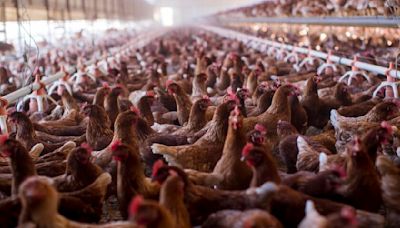Search results
People also ask
What causes salmonella poisoning?
Where does Salmonella come from?
What is Salmonella infection?
What causes Salmonella a complication?
CDC estimates Salmonella bacteria cause about 1.35 million infections, 26,500 hospitalizations, and 420 deaths in the United States every year. Food is the source for most of these illnesses. Most people who get ill from Salmonella have diarrhea, fever, and stomach cramps.
- Questions & Answers
Children under 5 years old are the most likely to get a...
- Diagnosis & Treatment
Salmonella infection is diagnosed when a laboratory test...
- For Health Professionals
The most common serotypes of Salmonella that cause human...
- Symptoms
Most people with a Salmonella infection experience:....
- Previous Outbreaks
When two or more people get the same illness from the same...
- Surveillance
2 Campylobacter, Cryptosporidium, Cyclospora, Listeria,...
- Communication Materials
Key links: Vital Signs for Food Safety: A Vital Signs report...
- Reports & Publications
Salmonella Atlas. CDC has posted a 248 page Salmonella Atlas...
- Salmonella Atlas
An Atlas of Salmonella in the United States, 1968-2011 pdf...
- Salmonella and Food
Causes of Salmonella Infection. You can get a Salmonella...
- Questions & Answers
- On this page
- Symptoms
- When to see a doctor
- From Mayo Clinic to your inbox
- Causes
- Risk factors
- Complications
- Prevention
- News from Mayo Clinic
•Overview
•Symptoms
•When to see a doctor
•Causes
•Risk factors
•Complications
Salmonella infection is usually caused by eating raw or undercooked meat, poultry, and eggs or egg products or by drinking unpasteurized milk. The incubation period — the time between exposure and illness — can be 6 hours to 6 days. Often, people who have salmonella infection think they have the stomach flu.
Possible signs and symptoms of salmonella infection include:
•Diarrhea
•Stomach (abdominal) cramps
•Fever
•Nausea
Most people don't need to seek medical attention for salmonella infection because it clears up on its own within a few days.
However, if the affected person is an infant, young child, older adult or someone with a weakened immune system, call a health care provider if illness:
•Lasts more than a few days
•Is associated with high fever or bloody stools
•Appears to be causing dehydration, with signs such as such as urinating less than usual, dark-colored urine and having a dry mouth and tongue
Request an appointment
Sign up for free and stay up to date on research advancements, health tips, current health topics, and expertise on managing health. Click here for an email preview.
To provide you with the most relevant and helpful information, and understand which information is beneficial, we may combine your email and website usage information with other information we have about you. If you are a Mayo Clinic patient, this could include protected health information. If we combine this information with your protected health information, we will treat all of that information as protected health information and will only use or disclose that information as set forth in our notice of privacy practices. You may opt-out of email communications at any time by clicking on the unsubscribe link in the e-mail.
Infected food and water
Commonly infected foods include:
Improperly handled food
Many foods become contaminated when prepared by people who don't wash their hands thoroughly after using the toilet or changing a diaper or after handling contaminated food.
Infected surfaces
Infection can also occur if people touch something that is contaminated and then put their fingers in their mouths.
Increased exposure Stomach or bowel disorders
The body has many natural defenses against salmonella infection. For example, strong stomach acid can kill many types of salmonella bacteria. But some medical problems or medications can short-circuit these natural defenses. Examples include:
Immune problems
Some medical problems or medications appear to increase your risk of catching salmonella by weakening your immune system. This interferes with your body's ability to fight infection and disease. Examples include:
Dehydration
If you can't drink enough to replace the fluid you're losing from diarrhea, you may become dehydrated. Warning signs include:
Bacteremia
If salmonella infection enters your bloodstream (bacteremia), it can infect tissues throughout your body, including:
Reactive arthritis
People who have had salmonella are at higher risk of developing reactive arthritis from salmonella infection. Also known as Reiter's syndrome, reactive arthritis typically causes:
The U.S. Department of Agriculture (USDA) oversees and updates inspection, sampling and testing programs for poultry and meat. The purpose is to cut the number of salmonella infections in the United States.
You can avoid getting salmonella and spreading bacteria to others in several ways, including safely preparing food, hand-washing, avoiding contamination, and not eating raw meat, dairy or egg products.
•Mayo Clinic Minute: Keeping Thanksgiving salmonella-free
•Mayo Clinic Minute: Tips to avoid salmonella infection
Aug 24, 2022 · What are some common causes of salmonella outbreaks? Many kinds of food have caused salmonella outbreaks, including peanut butter, packaged meats, frozen food and produce. Salmonella outbreaks from animals include pet turtles, lizards, chickens, hedgehogs and guinea pigs.
Oct 3, 2022 · Age and Gender. Causes and Risk Factors. Salmonella is one of the most common foodborne illnesses in the United States, causing approximately 1.35 million infections yearly. Salmonella infection (salmonellosis) is commonly spread by fecal-oral transmission.
Foodborne Pathogens. Salmonella (Salmonellosis) Salmonella are a group of bacteria that can cause gastrointestinal illness and fever called salmonellosis. Salmonella can be spread by food...
Feb 20, 2018 · Key facts. Salmonella is 1 of 4 key global causes of diarrhoeal diseases. Most cases of salmonellosis are mild; however, sometimes it can be life-threatening. The severity of the disease depends on host factors and the serotype of Salmonella.







